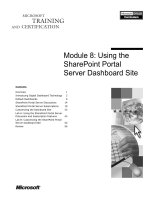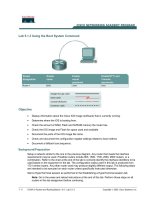Using the HTML5 Filesystem API ppt
Bạn đang xem bản rút gọn của tài liệu. Xem và tải ngay bản đầy đủ của tài liệu tại đây (5.23 MB, 72 trang )
www.it-ebooks.info
www.it-ebooks.info
Using the HTML5 Filesystem API
www.it-ebooks.info
www.it-ebooks.info
Using the HTML5 Filesystem API
Eric Bidelman
Beijing
•
Cambridge
•
Farnham
•
Köln
•
Sebastopol
•
Tokyo
www.it-ebooks.info
Using the HTML5 Filesystem API
by Eric Bidelman
Copyright © 2011 Eric Bidelman. All rights reserved.
Printed in the United States of America.
Published by O’Reilly Media, Inc., 1005 Gravenstein Highway North, Sebastopol, CA 95472.
O’Reilly books may be purchased for educational, business, or sales promotional use. Online editions
are also available for most titles (). For more information, contact our
corporate/institutional sales department: (800) 998-9938 or
Editors: Mike Loukides and Meghan Blanchette
Proofreader: O’Reilly Production Services
Cover Designer: Karen Montgomery
Interior Designer: David Futato
Illustrator: Robert Romano
Printing History:
July 2011: First Edition.
Nutshell Handbook, the Nutshell Handbook logo, and the O’Reilly logo are registered trademarks of
O’Reilly Media, Inc. Using the HTML5 Filesystem API, the image of a Russian greyhound, and related
trade dress are trademarks of O’Reilly Media, Inc.
Many of the designations used by manufacturers and sellers to distinguish their products are claimed as
trademarks. Where those designations appear in this book, and O’Reilly Media, Inc. was aware of a
trademark claim, the designations have been printed in caps or initial caps.
While every precaution has been taken in the preparation of this book, the publisher and author assume
no responsibility for errors or omissions, or for damages resulting from the use of the information con-
tained herein.
ISBN: 978-1-449-30945-9
[LSI]
1311183257
www.it-ebooks.info
Table of Contents
Preface . . . . . . . . . . . . . . . . . . . . . . . . . . . . . . . . . . . . . . . . . . . . . . . . . . . . . . . . . . . . . . . . . . . . . vii
1. Introduction . . . . . . . . . . . . . . . . . . . . . . . . . . . . . . . . . . . . . . . . . . . . . . . . . . . . . . . . . . . 1
Use Cases 1
Security Considerations 3
Browser Support 3
A Cautionary Tale 3
2. Storage and Quota . . . . . . . . . . . . . . . . . . . . . . . . . . . . . . . . . . . . . . . . . . . . . . . . . . . . . . 5
Storage Types 5
Temporary Storage 6
Persistent Storage 6
Unlimited Storage 7
Quota Management API 8
Requesting More Storage 8
Checking Current Usage 9
3. Getting Started . . . . . . . . . . . . . . . . . . . . . . . . . . . . . . . . . . . . . . . . . . . . . . . . . . . . . . . . 11
Opening a Filesystem 11
Handling Errors 13
4. Working with Files . . . . . . . . . . . . . . . . . . . . . . . . . . . . . . . . . . . . . . . . . . . . . . . . . . . . . 15
The FileEntry 15
Creating a File 16
Reading a File by Name 17
Writing to a File 18
Appending Data to a File 19
Importing Files 20
Using <input type=“file”> 21
Using HTML5 Drag and Drop 22
Using XMLHttpRequest 24
v
www.it-ebooks.info
Using Copy and Paste 27
Removing Files 28
5. Working with Directories . . . . . . . . . . . . . . . . . . . . . . . . . . . . . . . . . . . . . . . . . . . . . . . . 31
The DirectoryEntry 31
Creating Directories 32
Subdirectories 33
Reading the Contents of a Directory 34
Removing Directories 36
Recursively Removing a Directory 36
6.
Copying, Renaming, and Moving Entries . . . . . . . . . . . . . . . . . . . . . . . . . . . . . . . . . . . 37
Copying a File or Directory 37
Moving a File or Directory 39
Renaming a File or Directory 40
7. Using Files . . . . . . . . . . . . . . . . . . . . . . . . . . . . . . . . . . . . . . . . . . . . . . . . . . . . . . . . . . . . 43
Filesystem URLs 43
Summary 45
Blob URLs 45
Summary 49
Data URLs 49
Summary 50
8. The Synchronous API . . . . . . . . . . . . . . . . . . . . . . . . . . . . . . . . . . . . . . . . . . . . . . . . . . . 53
Introduction 53
Opening a Filesystem 53
Working with Files and Directories 54
Handling Errors 54
Examples 54
Fetching All Entries in the Filesystem 55
Downloading Files Using XHR2 56
vi | Table of Contents
www.it-ebooks.info
Preface
Conventions Used in This Book
The following typographical conventions are used in this book:
Italic
Indicates new terms, URLs, email addresses, filenames, and file extensions.
Constant width
Used
for program listings, as well as within paragraphs to refer to program elements
such as variable or function names, databases, data types, environment variables,
statements, and keywords.
Constant width bold
Shows commands or other text that should be typed literally by the user.
Constant width italic
Shows text that should be replaced with user-supplied values or by values deter-
mined by context.
This icon signifies a tip, suggestion, or general note.
This icon indicates a warning or caution.
Using Code Examples
This
book is here to help you get your job done. In general, you may use the code in
this book in your programs and documentation. You do not need to contact us for
permission unless you’re reproducing a significant portion of the code. For example,
writing a program that uses several chunks of code from this book does not require
permission. Selling or distributing a CD-ROM of examples from O’Reilly books does
vii
www.it-ebooks.info
require permission. Answering a question by citing this book and quoting example
code does not require permission. Incorporating a significant amount of example code
from this book into your product’s documentation does require permission.
We appreciate, but do not require, attribution. An attribution usually includes the title,
author, publisher, and ISBN. For example: “Using the HTML5 Filesystem API by Eric
Bidelman (O’Reilly). Copyright 2011 Eric Bidelman, 978-1-449-30945-9.”
If you feel your use of code examples falls outside fair use or the permission given above,
feel free to contact us at
Safari® Books Online
Safari Books Online is an on-demand digital library that lets you easily
search over 7,500 technology and creative reference books and videos to
find the answers you need quickly.
With a subscription, you can read any page and watch any video from our library online.
Read books on your cell phone and mobile devices. Access new titles before they are
available for print, and get exclusive access to manuscripts in development and post
feedback for the authors. Copy and paste code samples, organize your favorites, down-
load chapters, bookmark key sections, create notes, print out pages, and benefit from
tons of other time-saving features.
O’Reilly Media has uploaded this book to the Safari Books Online service. To have full
digital access to this book and others on similar topics from O’Reilly and other pub-
lishers, sign up for free at .
How to Contact Us
Please address comments and questions concerning this book to the publisher:
O’Reilly Media, Inc.
1005 Gravenstein Highway North
Sebastopol, CA 95472
800-998-9938 (in the United States or Canada)
707-829-0515 (international or local)
707-829-0104 (fax)
We have a web page for this book, where we list errata, examples, and any additional
information. You can access this page at:
/>To comment or ask technical questions about this book, send email to:
viii | Preface
www.it-ebooks.info
For more information about our books, courses, conferences, and news, see our website
at .
Find us on Facebook: />Follow us on Twitter: />Watch us on YouTube: />Preface | ix
www.it-ebooks.info
www.it-ebooks.info
CHAPTER 1
Introduction
As we move from an offline world to a completely online world, we’re demanding more
from the Web, and more from web applications. Browser implementers are adding
richer APIs by the day to support complex use cases. APIs for things like real-time
communication, graphics, and client-side (offline) storage.
One area where the Web has lacked for some time is file I/O. Interacting with binary
data and organizing that data into a meaningful hierarchy of folders is something desk-
top software has been capable of for decades. How amazing would it be if web apps
could do the same? The lack of true filesystem access has hindered web applications
from moving forward. For example, how can a photo gallery work offline without being
able to save images locally? The answer is it can’t! We need something more powerful.
The HTML5 File API: Directories and System aims to fill this void. The specification
defines a means for web applications to read, create, navigate, and write to a sandboxed
section of the user’s local filesystem. The entirety of the Filesystem API can be broken
down into a number of different related specifications:
• Reading and manipulating files: File/Blob, FileList, FileReader
• Creating and writing: BlobBuilder, FileWriter
• Directories and filesystem access: DirectoryReader, FileEntry/DirectoryEntry,
LocalFileSystem
The specification defines two versions (asynchronous and synchronous) of the same
API. The asynchronous API is useful for normal applications and prevents blocking UI
actions. The synchronous API is reserved for use in Web Workers.
Use Cases
HTML5 has several storage options available. The Filesystem API is different in that it
aims to satisfy client-side storage use cases not well served by databases such as In-
dexedDB or WebSQL DB. Generally, these are applications that deal with large binary
1
www.it-ebooks.info
blobs and share data with applications outside of the context of the browser. The spec-
ification lists several use cases worth highlighting:
• Persistent uploader
— When a file or directory is selected for upload, it copies the files into a local
sandbox and uploads a chunk at a time.
— Uploads can be restarted after browser crashes, network interruptions, etc.
• Video game, music, or other apps with lots of media assets
— It downloads one or several large tarballs, and expands them locally into a di-
rectory structure.
— The same download works on any operating system.
— It can manage prefetching just the next-to-be-needed assets in the background,
so going to the next game level or activating a new feature doesn’t require waiting
for a download.
— It uses those assets directly from its local cache, by direct file reads or by handing
local URIs to image or video tags, WebGL asset loaders, etc.
— The files may be of arbitrary binary format.
— On the server side, a compressed tarball is often much smaller than a collection
of separately compressed files. Also, one tarball instead of a 1,000 little files
involves fewer seeks.
• Audio/Photo editor with offline access or local cache for speed
— The data blobs are potentially quite large, and are read-write.
— It might want to do partial writes to files (overwriting just the ID3/EXIF tags,
for example).
— The ability to organize project files by creating directories is important.
— Edited files should be accessible by client-side applications (iTunes, Picasa).
• Offline video viewer
— It downloads large files (>1 GB) for later viewing.
— It needs efficient seek and streaming.
— It should be able to hand a URI to the video tag.
— It should enable access to partly downloaded files (for example, to let you watch
the first episode of the DVD even if your download didn’t complete before you
got on the plane.)
— It should be able to pull a single episode out of the middle of a download and
give just that to the video tag.
• Offline web mail client
— Downloads attachments and stores them locally.
— Caches user-selected attachments for later upload.
2 | Chapter 1: Introduction
www.it-ebooks.info
— Needs to be able to refer to cached attachments and image thumbnails for dis-
play and upload.
— Should be able to trigger the UA’s download manager just as if talking to a server.
— Should be able to upload an email with attachments as a multipart post, rather
than sending a file at a time in an XHR.
Security Considerations
The HTML5 Filesystem API can be used to read and write data to parts of the user’s
hard drive. Because of this privileged access, there are a number of security and privacy
issues that have been considered in the API’s design. A few are listed below:
• Local disk usage and IO bandwidth—this is mitigated in part through quota lim-
itations. See Chapter 2, Storage and Quota.
• Leakage or erasure of private data—this is mitigated by limiting the scope of the
HTML5 filesystem to a chroot-like, origin-specific sandbox. Applications cannot
access another domain/origin’s filesystem.
• Storing malicious executables or illegal data on a user’s system—with any down-
load there is a risk. The API mitigates against malicious executables by restricting
file creation/rename to nonexecutable extensions, and by making sure the execute
bit is not set on any file created or modified via the API.
Browser Support
At the time of writing, Google Chrome is the only browser to implement the Filesystem
API. Version 8 of the browser was the first to see a partial implementation, but the
majority of the API was later completed in version 11. In Chrome 13, a Chapter 2,
Storage and Quota API was added to give applications a way to request addition space
for storing data.
A Cautionary Tale
Before we dive in, I want to remind you that this book covers a working implementation
of an evolving specification, a spec that has yet to be finalized by the World Wide Web
Consortium (W3C). Take my word of caution and realize that until the spec is final,
portions of the API could change.
Browser Support | 3
www.it-ebooks.info
www.it-ebooks.info
CHAPTER 2
Storage and Quota
The HTML5 Filesystem API gives applications the facility to write and store actual files
in JavaScript. That is amazing, but with great power comes great responsibility. Web-
sites now have the potential to store large amounts of binary data on a user’s system.
It is important that applications do not abuse such a gift by, for example, eating up
large amounts of disk space without the user’s knowledge or consent. The last thing
users want is to have 20 GB of data stored on their system just by visiting a URL.
At the time of writing, Chrome has a limited UI settings page for users to manage the
storage space for applications that save data on their behalf. It is accessible via Prefer-
ences→Under the Hood→All Cookies and Site Data (or by opening chrome://settings/
cookies). Users can only delete data from this menu. As a result of this limited UI, write
operations (such as creating a folder and writing to a file) require an application to ask
for the estimated size, in bytes, they expect to use. The same practice is true for other
offline storage APIs, like WebSQL DB, where one opens a database with a particular
size:
var db = window.openDatabase(
'MyDB', // dbName
'1.0', // version
'test database', // description
2 * 1024 * 1024, // estimatedSize in bytes (2MB)
function(db) {} // optional creationCallback
);
Storage Types
A normal web application can request storage space under two classifications: tempo-
rary or persistent. In addition to these types, Chrome Extensions and hosted web ap-
plications listed in the Chrome Web Store have a third option: unlimited storage.
5
www.it-ebooks.info
Temporary Storage
Temporary storage is easiest to obtain. In fact, you don’t even need to request it. By
default, origins are given a modest amount of temporary storage, meaning they can use
temporary storage without special permissions or the browser prompting the user to
take some action. Temporary storage is perfect for things like caching.
In Google Chrome 13, the HTML5 Filesystem and the WebSQL DB share a pool of
disk space that sites can collectively consume. A single site can consume up to 20% of
the pool. As usage of the temporary pool approaches the limit for the pool as a whole
(1 GB), least recently used data will be reclaimed. Eventually, Application Cache and
IndexedDB will also share in this temporary pool. Such a unified quota system also
means there is no longer a 5 MB limit imposed on WebSQL DB.
When the browser deletes temporary data it deletes all the data stored
for the origin. This guarantees data won’t be corrupt in an unexpected
way.
Properties of temporary storage:
• Browser does not prompt the user on first use.
• Apps are granted a reasonable amount of temporary storage by default.
• Data is not guaranteed to still exist. It might be deleted at the browser’s discretion
when the local disk’s available space.
Persistent Storage
Persistent storage is just that, persistent. Data saved using this option is available on
subsequent accesses to the same filesystem. Keep in mind, though, that even persistent
data can be deleted manually by the user (either through a browser settings page or
through direct filesystem operations on the OS). So the data you save is never 100%
guaranteed to be there.
A key difference from temporary storage is that the browser asks the user for permission
before allocating persistent storage space. In Chrome, this displays as an info bar (see
Figure 2-1).
6 | Chapter 2: Storage and Quota
www.it-ebooks.info
Figure 2-1. The browser prompts the user when persistent storage is requested
Because user intervention is involved in this storage option, apps are granted zero per-
sistent quota by default. Any attempts to store more data than the granted quota will
fail with QUOTA_EXCEEDED_ERR.
Properties of PERSISTENT storage:
• Browser prompts the user if additional space is requested.
• Apps are granted zero quota by default.
• If more storage space is needed, it can be requested. There is no fixed size storage
pool.
• Data is guaranteed to be available on subsequent accesses.
Unlimited Storage
Unlimited storage is a unique option to Chrome Extensions and Apps listed in the
Chrome Web Store (either hosted or installed). Using the unlimitedStorage permission
in the .manifest file, one can bypass the restricts of temporary and persistent storage.
Think of unlimited storage as persistent storage, but without a user prompt and max-
imum cap.
Properties of unlimitedStorage:
• Exclusive to Chrome Apps and Extensions.
• Unlimited quota is granted with no user prompts (except at installation time).
• No need to request more storage when more is needed.
Chrome can be run with an unlimited-quota-for-files flag, which
also allows unlimited storage. However, flags are temporary and should
only be used for testing purposes. Running your primary browser with
this flag gives free reign to an application, allowing it to store as much
data on your hard drive as it wants. You should only use unlimited-
quota-for-files during testing.
Storage Types | 7
www.it-ebooks.info
Quota Management API
Chrome 13 added a quota management API to give applications a tool for requesting,
managing, and most importantly, querying the current amount of storage their origin
is taking up. The API is exposed as a new global object, webkitStorageInfo:
window.webkitStorageInfo
The quota API is prefixed because it is not standardized yet. It has two methods:
queryUsageAndQuota (type, opt_successCallback, opt_errorCallback);
type
The type of storage to return the current usage for. Possible values are TEMPO
RARY or PERSISTENT.
opt_successCallback
An optional two parameter callback. The parameters are the current number
of bytes the app is using and current quota, also in bytes.
opt_errorCallback
An optional error callback.
requestQuota (type, size, opt_successCallback, opt_errorCallback);
type
Whether the new/additional storage should be persistent or temporary. Pos-
sible values are TEMPORARY or PERSISTENT.
opt_successCallback
An optional callback passed the granted quota in bytes.
opt_errorCallback
An optional error callback.
Requesting More Storage
To request new or additional storage space, call requestQuota() with the type of storage,
size, and a success callback. As explained in the previous section, the browser prompts
the user with a permission bar when PERSISTENT storage is requested. If the size passed
to requestQuota() is less than the app’s current allocation, no prompt is shown. The
current quota is kept. If your app is requesting additional space (e.g., the new size is
larger than the app’s existing quota), the user will be reprompted to accept that change.
If the request is for TEMPORARY storage, again, no prompt will appear but other data may
be evicted at the browsers discretion.
The following example requests 2 MB of PERSISTENT storage:
window.webkitStorageInfo.requestQuota(PERSISTENT, 2*1024*1024, function(bytes) {
console.log('Granted ' + bytes + ' bytes in persistent storage');
}, function(e) {
console.log('Error', e);
});
8 | Chapter 2: Storage and Quota
www.it-ebooks.info
Checking Current Usage
To query the current storage usage and quota of an application, call queryUsageAnd
Quota() with the type of storage you’re interested in checking and a success callback.
This method returns two things to your callback, the number of bytes being used, and
the total quota for the storage type in question.
For example, if example.com wanted to check the percentage of TEMPORARY storage it is
using, it could run:
window.webkitStorageInfo.queryUsageAndQuota(TEMPORARY, function(usage, quota) {
console.log('Using: ' + (usage / quota) * 100 + '% of temporary storage');
}, function(e) {
console.log('Error', e);
});
The usage reported by the quota API might not precisely match the size that was re-
quested using requestQuota() or the actual size of the stored data on disk. The dis-
crepancy comes from each storage type needing some extra bytes to store meta data.
There may also be some time lag until updates are reflected to the quota API.
Quota Management API | 9
www.it-ebooks.info
www.it-ebooks.info
CHAPTER 3
Getting Started
Opening a Filesystem
A web application obtains access to the HTML5 Filesystem by requesting a LocalFile
System object using a global method, window.requestFileSystem():
window.requestFileSystem(type, size, successCallback, opt_errorCallback)
This method is currently vendor prefixed as window.webkitRequestFile
System.
Its parameters are described below:
type
Whether the storage should be persistent. Possible values are TEMPORARY or PERSIS
TENT. Data stored using TEMPORARY can be removed at the browser’s discretion (for
example if more space is needed). PERSISTENT storage cannot cleared unless ex-
plicitly authorized by the user or the application.
size
An indicator of how much storage space, in bytes, the application expects to need.
successCallback
A callback function that is called when the user agent successfully provides a file-
system. Its argument is a FileSystem object.
opt_errorCallback
An optional callback function which is called when an error occurs, or the request
for a filesystem is denied. Its argument is a FileError object.
Calling window.requestFileSystem() for the first time creates a new sandboxed storage
space for the app and origin that requested it. A filesystem is restricted to a single
application and cannot access another application’s stored data. This also means that
11
www.it-ebooks.info
an application cannot read/write files to an arbitrary folder on the user’s hard drive
(such as My Pictures or My Documents). Each filesystem is isolated.
Example 3-1. Requesting a filesystem temporary storage
var onError = function(fs) {
console.log('There was an error');
};
var onFS = function(fs) {
console.log('Opened filesystem: ' + fs.name);
};
window.requestFileSystem(window.TEMPORARY, 5*1024*1024 /*5MB*/, onFs, onError);
If all goes well, the success callback (onFS) is called and passed a FileSystem object
containing two properties:
name
A unique name for the filesystem, assigned by the browser
root
A read-only DirectoryEntry representing the root of the filesystem
The FileSystem object is your gateway to the entire API. Once you have a reference,
it’s worth caching it in a global variable or class property. You’ll use it all over the place.
Things get a bit more complicated when using persistent storage with the filesystem.
The previous chapter explained that applications are granted zero persistent quota by
default. As a result, you need to request some persistent quota before opening the
filesystem. That might mean simply wrapping the call to window.requestFileSystem()
in the requestQuota() callback.
Example 3-2. Requesting a filesystem with persistent storage
const SIZE = 5*1024*1024; /*5MB*/
const TYPE = PERSISTENT;
window.webkitStorageInfo.requestQuota(TYPE, SIZE, function(grantedBytes) {
window.requestFileSystem(TYPE, grantedBytes, onFs, onError);
}, function(e) {
console.log('Error', e);
});
After the user grants permission to use persistent storage, your app is allocated the
amount of quota it requested. There’s no need to ask for more quota until space be-
comes an issue. When that point comes, the best way to recover is to attempt the write
operation, catch the QUOTA_EXCEEDED_ERR in the error callback, and request more per-
sistent storage using requestQuota(). Don’t worry if none of that makes sense now. It
will in the next chapter, Chapter 4, Working with Files.
12 | Chapter 3: Getting Started
www.it-ebooks.info
Handling Errors
Error callbacks are optional arguments to the API’s methods. However, it is always a
good idea to catch errors for users, as there are a number of places where things can go
wrong. For example, if you run out of quota, write access to the filesystem is denied,
or a disk I/O operation fails.
Error callbacks are passed FileError objects, which contain a code corresponding to
the type of error that occurred. The code can be compared to the enum constants in
FileError.
Example 3-3. Generic error handler
function onError(err) {
var msg = 'Error: ';
switch (err.code) {
case FileError.NOT_FOUND_ERR:
msg += 'File or directory not found';
break;
case FileError.SECURITY_ERR:
msg += 'Insecure or disallowed operation';
break;
case FileError.ABORT_ERR:
msg += 'Operation aborted';
break;
case FileError.NOT_READABLE_ERR:
msg += 'File or directory not readable';
break;
case FileError.ENCODING_ERR:
msg += 'Invalid encoding';
break;
case FileError.NO_MODIFICATION_ALLOWED_ERR:
msg += 'Cannot modify file or directory';
break;
case FileError.INVALID_STATE_ERR:
msg += 'Invalid state';
break;
case FileError.SYNTAX_ERR:
msg += 'Invalid line-ending specifier';
break;
case FileError.INVALID_MODIFICATION_ERR:
msg += 'Invalid modification';
break;
case FileError.QUOTA_EXCEEDED_ERR:
msg += 'Storage quota exceeded';
break;
case FileError.TYPE_MISMATCH_ERR:
msg += 'Invalid filetype';
break;
case FileError.PATH_EXISTS_ERR:
msg += 'File or directory already exists at specified path';
break;
default:
Handling Errors | 13
www.it-ebooks.info









